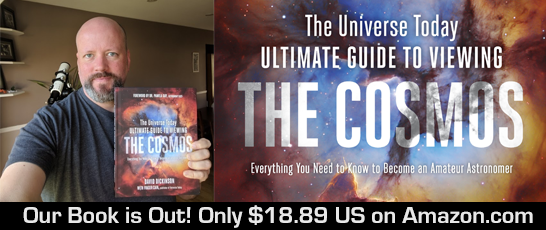Now that the SpaceX Starship is starting to take shape, journalists are trying to wrap their minds around what this monster rocket will do to the commercial launch industry. But in the opinion of aerospace engineer Casey Handmer, they're not really appreciating the true scope of this accomplishment. In fact, Starship isn't big, it's about as small as it could possibly be and still provide a fully reusable trip to space. And when it does start flying, it's going to be capable of sending so much cargo into space, it'll dwarf the rest of the commercial launch industry. This was a really fascinating article, and I highly recommend you give it a read.
The SpaceX Starship is a Very Big Deal
Thanks!
Fraser Cain
Publisher
Universe Today
As always, if you have comments or questions, or suggestions on how I can improve this newsletter, please don't hesitate to reply this email or email me at info@universetoday.com.
Patrons, don't forget to login to Universe Today. That'll remove all the ads for you. Join the 843 Patrons who get our videos early, see behind the scenes, and get no ads on Universe Today.
Surviving On Venus. Is It Time To Go Back To That Awful Place?
If you've watched this channel enough, you might have the impression that I hate Venus. It's possible, just possible I've even suggested that the planet is so terrible it should be pushed into the Sun. The reality, of course, is that it's an absolutely fascinating world - the closest twin to the Earth that we have in the Solar System. It's nearly the same mass and has the same surface gravity. While Earth is the beautiful life-filled world we all enjoy, Venus is a tortured hellscape, with temperatures hot enough to melt zinc. With atmospheric pressures more than 93 times what we experience here on the surface of Earth. And I always forget about the sulphuric acid rain. The Soviets sent a series of landers to a horrible demise for a glimpse of the surface of Venus in the 70s and 80s. But nobody's been back since. There have been new techniques and technologies in development that might make a serious exploration of the surface of Venus possible again. Exploration that could help us understand why the planet went so horribly horribly wrong.
Subscribe to our podcasts:
Universe Today Guide to Space Audio: iTunes - RSS
Audio versions of all the media I upload to my YouTube channel, as well as bonus content, behind the scenes, interviews with Fraser and more
Astronomy Cast: iTunes - RSS
Your weekly facts-based journey through the cosmos, which I co-host with astronomer Dr. Pamela Gay. We have episodes on every concept in space and astronomy, from black holes to the history of astronomy.
Weekly Space Hangout: iTunes - RSS
A weekly round-up of all the breaking space news. Rocket launches, new discoveries from Hubble, and planetary science by three PhD astronomers... and me.
New Horizons Team Pieces Together the Best Images They Have of Pluto's Far Side
When NASA's New Horizons spacecraft flew past Pluto in the summer of 2015, it was really only able to image about half of the world in high resolution. But it did take images when it was farther out that gave astronomers a glimpse of its surface. Now scientists working with the mission have mapped out the far side to the best of their ability, giving us a glimpse of what that other half looks like.
Skylon's SABRE Engine Passes a Big Test
One of the dreams of spaceflight is a single-stage to orbit spaceplane, or an SSTO. The challenge is making an engine that can use atmospheric oxygen at lower altitudes and then transition to a rocket engine is it gets into space. UK's Reaction Engine Limited made passed a big test last week with their SABRE engine, testing out a precooler that was able to cool down hot air coming into the engine at Mach 5.
Breakthrough Listen and NASA Team Up to Look for Signs of Extra-Terrestrial Intelligence!
NASA's TESS mission is turning up new exoplanets relatively close to Earth, and each one of them could be a great target for the search for extraterrestrials. This week, Breakthrough Listen announced a partnership with scientists working on TESS to do followup studies on these planets, searching for "technosignatures" - any indication of intelligent life. TESS is expected to find over 10,000 planets, so they'll have a lot of targets to scan.
Astronomers See the Wreckage from a Collision Between Exoplanets
Astronomers think they've found evidence of a massive collision between planets orbiting another star; a similar situation which might have formed the Earth's Moon, billions of years ago. They found swirling hot debris in a star system located about 300 light-years away. The system is at least a billion years old; any wreckage should have cooled down by now, so the astronomers think it must have formed recently.
InSight's Heat Probe Has Bounced Back Out Of Its Hole
Last week I told you that the temperature probe on NASA's InSight mission was finally making progress, hammering its way down into the Martian regolith to take the planet's temperature. Unfortunately, it looks like Mars has rejected the probe, pushing it back out of the ground. NASA is considering new plans, but there's no easy way to extract the probe and then redeploy it.
These Weirdo Stellar Corpses Have Creamy Centers Filled with Exotic Quantum Liquids
When a star like our Sun dies, it turns into a white dwarf, and then cools down to the background temperature of the Universe. And now researchers have built a model that simulates what's going on inside one of these extreme - and extremely dead - stars. They can have temperatures hotter than a million kelvin, a thin atmosphere of hydrogen, and an exotic interior of quantum liquid carbon and oxygen.
New Telescope Instrument Will Watch the Sky with 5,000 Eyes
Dark energy is that mysterious force that's accelerating the expansion of the Universe, and still nobody knows exactly what it is. But a new telescope instrument called the Dark Energy Spectroscopic Instrument is going to turn 5,000 robotic eyes on the sky to help figure it out. This instrument was recently attached to the 4-meter Mayall Telescope at the Kitt Peak National Observatory.
SpaceX is Sure They'll be Able to Land Starship on the Moon in 2022
While NASA is working on sending humans to the Moon by 2024, SpaceX thinks that's going about it too slowly. President Gwynne Shotwell announced at a recent conference that the company is planning to send their Starship rocket to the Moon by 2022, and sending humans shortly after that. SpaceX is hoping for Starship to take its first orbital flight by next year, so stay tuned.
X-37B Lands After 780 Days in Orbit Doing ???
After 780 days in orbit, the US Air Force's mysterious X-37B spaceplane touched down at the Kennedy Space Center. What was it doing up there for over two years? That's classified, and nobody from the Air Force is telling us. Apparently it advanced capabilities, completed objectives, performed experiments, launched satellites, and helped the US maintain superiority in space, and did other vague things, stuff 'n junk.
NASA is Testing a Rover That Could Search For Water Ice on The Moon
NASA's Artemis program is focusing its sights on the Moon's southern pole, where there could be huge reserves of water ice. As part of that search, NASA is building a new lunar rover that's expected to fly to the Moon by 2022 and crawl around the surface scanning for water. The rover is called the Volatiles Investigating Polar Exploration Rover, which turns into the cool acronym "VIPER".
Clouds On Jupiter Rising Up Above the Surrounding Atmosphere
Here's another incredible image of Jupiter captured by NASA's Juno spacecraft. And the bright spots near the center of the image are regions where clouds are rising up above the surrounding atmosphere. Jupiter's bands of clouds can actually extend deep below the surface, down to 3,000 km, but the upper cloud layer is much smaller, just 50 km deep.
This is the Machine Astronauts Trained on to Land on the Moon
When NASA astronauts were training to fly to the Moon, they honed their skills on the Lunar Landing Research Vehicles (or LLRVs). They had turbofans that mimicked the lunar gravity by counteracting 5/6ths of the vehicle's weight. The astronauts had to manually control the rest to lift off, fly around and then touch down gently on the "Moon". If you watched the movie "First Man", this is the vehicle that Neil Armstrong had to eject away from.
Other Interesting Space Stuff
- NASA sets launch date for Starliner mission to space station
- India's Chandrayaan-2 sees boulders and craters on the Moon
- More evidence that a meteor strike caused an extinction 13,000 years ago
- A simulation of the Universe's first moments helps explain its initial expansion
- Mars 2020 stands up on its wheels for the first time
- This is your brain, on spaceflight
- Giant Geode Grew Slow and Steady
- A Japanese spacecraft is going to aim for a precision landing on the Moon
- Weekly Space Hangout: October 30, 2019 - Evelyn MacDonald on Finding Earth-Like Planets
- Simulations say that we should be able to see the helium flash from a star nearing the end of its life
- C/2016 R2 (Pan-STARRS): When a comet blue by
- Astronomers simulate how giant exoplanets can end up so close to their stars
- JWST schedule margin shrinks
- Level up: DeepMind's AlphaStar achieves Grandmaster level in StarCraft II
- NASA-JPL Holds Its Annual Pumpkin-Carving Contest
Amazing Astrophotography on @universetoday
Lagoon Nebula (Messier 8) by Brian Fulda
This beautiful photograph is an image of the famous Lagoon Nebula, aka Messier 8. It was captured by @absorbingphotons using an 8" Orion f/3.9 Astrograph with a total of 1 hour and 20 minutes of exposure time.
We have featured thousands of astrophotographers on our Instagram page, which has more than 191,000 followers. Want to do a takeover? Use the hashtag #universetoday and I'll check out your photos.
Find your way across the night sky. Choose a variety of astronomy gear. Follow the Moon and the planets. Find deep sky objects across the seasons in both hemispheres. Observe comets, asteroids, satellites and space stations. Learn to do astrophotography.
Get it on Amazon for only $18.89. Here are some other options.
|


